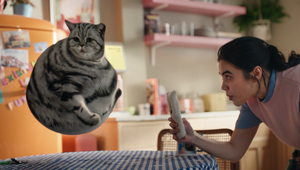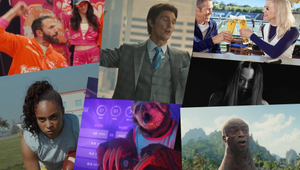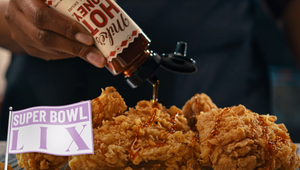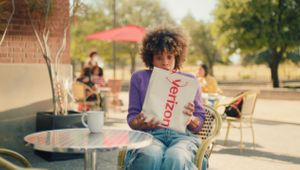
The Directors: Michael Gregory

Michael came to the industry by way of his graphic design degree he earned from Central St Martins. He has spent 10 years at MPC in London working as a VFX supervisor. In 2016, he moved to LA to work with MPC LA, and now The Mill, where he is the executive creative director. His impressive portfolio of work includes some of the industry’s most acclaimed commercials, including the double Cannes Gold Lion winning and triple VES winning Samsung ‘Do What You Can’t’ spot directed by Matthijs Van Heijningen. As a director, his spot for Arm and Hammer won Gold for ‘Best Animation in a Commercial’ at the 2021 VES awards. Between his work as a VFX supervisor and director, Michael has collected over 20 of the most sought-after awards in the industry.
Name: Michael Gregory
Location: Los Angeles
Repped by/in: The Mill, LA
Awards: VES Award - Arm & Hammer 'Once Upon a Time' (Outstanding Animated Character in a Commercial).
LBB> What elements of a script sets one apart from the other and what sort of scripts get you excited to shoot them?
Michael> Well, a good script for me is one that you can already visualise on first read. Ideas already spinning around the brain. The “formula” needs to be coming together already - “oh this would look great here...what if we did that there?” Simplicity and originality are also key. Not a copy of a copy. There should be just enough on the page for you to start getting excited by where you might take it.
LBB> How do you approach creating a treatment for a spot?
Michael> For me, it is all about getting my creative idea across. Normally, I’ll find a few key images that define an idea and use those as the base to then write the copy. I find that ‘Day One’ is all about collecting all your thoughts and really letting the mind go wild with the different possibilities. On Day Two I start eliminating the ones that don’t work and keep the ones that can be connected or built out. It’s important to make everything very clear - once someone has read your treatment, they need to understand exactly what you want to make. The tone, look, how you will execute it, and so on, all must be laid out from a creative's perspective. The team you’re working with might have been pitching and working on this idea for a year, so it is important to deliver your vision for it. The treatment needs to land in their inbox and be their idea returned as a fairground ride of ideas and excitement.
LBB> If the script is for a brand that you're not familiar with/ don’t have a big affinity with or a market you're new to, how important is it for you to do research and understand that strategic and contextual side of the ad? If it’s important to you, how do you do it?
Michael> It’s good to know the brand’s history and where that particular brand sits in the market. I normally watch some previous campaigns if I’m not aware of their previous work. It gives you a sense of who you are working with and shows the client that you can represent them. Normally, the brand will tell you any fears the client may have or watch outs – that can be helpful in avoiding any potential issues. It’s also good to be aware of the journey they have been on if you are making something new. How does your content fit or deviant from their past content? Now in the case the work might be for an existing successful campaign, the pressure is on; but sometimes you're looking to set a benchmark of a new campaign all together.
LBB> For you, what is the most important working relationship for a director to have with another person in making an ad? And why?
Michael> I think that is a rolling, everchanging list. It starts with your producer, but then you win the job and it’s your storyboard artist that is now the most important. Then the production designer takes over, then the DP, and so on in each critical stage of the work. Then, of course, your producer tells you you’re over budget and it’s the barman serving you a pint as you strategize that holds your focus. Then the PA, who’s helping you block a shot, comes back into importance, and the dance continues. Each project is a journey and having good working relationships with all the crew is so important to keep the line moving.
LBB> What type of work are you most passionate about - is there a particular genre or subject matter or style you are most drawn to?
Michael> Character work is a big part of my reel; I love to bring characters to life. I use live action combined with CG, and when you get the two right, it’s wonderful. Building a digital character from scratch is a very cool experience. From concepting, design, casting a real actor for performance, animation, voice casting, you get to see them literally become “alive.” Working in those character trait details is what gives you believability on screen: you can really push personality into them. You always need to start with a name. In a recent spot I made, a female cat says, “you can drink from my saucer anytime.” That’s a great inuendo line, so what did we do to capture that vibe? I looked at Christina Hendricks in Madmen as casting reference. We called her Kiki, made her a red head, and I cast a similar actress for the performance. We replace the head with CGI, but the performance and facial animation comes from the actor, and we gave her a sultry voice and big glasses that sat on the bridge of her nose. She had 2 seconds of screen time but absolutely nailed the character I wanted her to have. You must go “all in,” even if it is the smallest part.
LBB> What misconception about you or your work do you most often encounter and why is it wrong?
Michael> The misconception I sometimes see is that just because I tend to direct commercials that have a lot of visual effects, I can’t work outside of that. I can and I do! I’m just telling a story with my imagination.
LBB> Have you ever worked with a cost consultant and if so how have your experiences been?
Michael> My producers are the ones who work with cost consultants more directly. On my part, I’m very good at making every dollar go on screen. There’s a challenge to making budgets look bigger than they are. You work within your constraints and requirements, but there are definitely tricks and trades to make something look like it cost twice what it did.
LBB> What’s the craziest problem you’ve come across in the course of a production – and how did you solve it?
Michael> Trying to find a saloon we could film in during the COVID-19 pandemic. The world had been closed for quite some time, but my producer found one of the only countries that was open to film production. A couple of phone calls later, and low and behold we found they had a Saloon on a backlot just outside Sofia, Bulgaria. Four weeks later, I was directing a cowboy scene over zoom. It was a lot of fun. When the world opened up, I went back and shot on the stage there - it was nice to see everyone in person after working with them remotely. I didn’t realise they had my zoom audio on a loudspeaker for 2 days. I think some of the crew may never get over that.
LBB> How do you strike the balance between being open/collaborative with the agency and brand client while also protecting the idea?
Michael> I think if you have a good relationship and are open from the beginning then you can create that balance. That’s why storyboarding is so important: if the final film matches your boards, then the process has been successful, and the ideas have been honoured. If a client wants to start changing the idea after the shoot, then there has been a breakdown in the process somewhere, and we must revisit and revise. Being open and communicative during each step allows for a clean final product with all inputs being heard and understood.
LBB> What are your thoughts on opening up the production world to a more diverse pool of talent? Are you open to mentoring and apprenticeships on set?
Michael> The entry point should be accessible by all – no question. A healthy film industry is one that has an inclusive culture. Seeing people hungry to learn the craft is wonderful. Passing on knowledge and nurturing talent is essential. When I can I bring people out on set and get them that invaluable experience. Understanding how a film set works takes time. Watching a crew work together in perfect harmony to get the shot is an incredible thing to witness. I sometimes take that for granted and whenever I bring someone who is new to this world it reminds me how good it is.
LBB> How do you feel the pandemic is going to influence the way you work into the longer term? Have you picked up new habits that you feel will stick around for a long time?
Michael> The pandemic has been brilliant in breaking the mould of what a workplace should be. You have options. Your time can be much better utilised. You can choose if you want to attend sessions or be remote, depending on what would be the most efficient use of time, energy, and resources. Pre 2020, editing, color, sound, vfx all used to be in person, but now you have a choice. As a result, artists have a much better work life balance. This is important as it makes the work more sustainable for the artists in the long term. For me, the ability to direct remotely is a great option. While it is not my first choice, it works, especially if you are dealing with different locations. Ultimately, having multiple options is always better than being restricted to one.
LBB> Your work is now presented in so many different formats - to what extent do you keep each in mind while you're working (and, equally, to what degree is it possible to do so)?
Michael> It’s tricky shooting letterbox and covering for 9x16’s. The whole issue would be solved if everyone held their phones horizontally. That is never going to happen. So yes, it’s important to try and make sure the image is visually successful across all formats.
LBB> What’s your relationship with new technology and, if at all, how do you incorporate future-facing tech into your work (e.g. virtual production, interactive storytelling, AI/data-driven visuals etc)?
Michael> Technology undoubtedly drives the industry. Whether that is LED lights on set, cloud rendering in visual effects, AI driven rotoscope, or camera drones, these all make a huge difference. There are apps that tell you where the sun is and AR that lets you block out shots with an animated octopus; these are all examples of new tech that I use daily. Tech is amazing. The robots are really coming through for us. Be prepared.
LBB> Which pieces of work do you feel really show off what you do best – and why?
Arm and Hammer – AbsorbX
Treatment, Scout, Casting, Wardrobe, Production Design, Directing, Edit, Online, Voice Recording, Color, Sound Mix all 100% remote. Directed from my home office which was an old little table that I found on my street with my laptop on top. It went on to win a VES award for animation which is the highest accolade you can get in the industry.
Arm and Hammer – Slide
The follow up to Saloon. Disco funk vibes. Some great characters. Saturday Night Fever inspired moves. Fun Cat Pastiche.
Starburst – Duo’s
The agency script featured a half flamingo/half zebra I think, and it was set in the Serengeti. I thought it would be better if we switched it up and had the character as the family pet inside the living room. The project really shows that 15 seconds is an art form. Every frame counts; in this time, we had to tell you what the product is and also relay the backstory of this guy Carl being the dad. Bonkers.
Fiji Water – Drop
This is where it started. This producer came to me and asked me how I would approach a water drop coming from a cloud and landing in the Fijian jungle. I told them how to do it. They asked if I wanted to treat on it. Next thing I know I'm scouting mountains in Fiji. We then came back and I shot the incredible Allyson Felix in downtown Los Angeles. That job was my directing debut and it all started from there.















